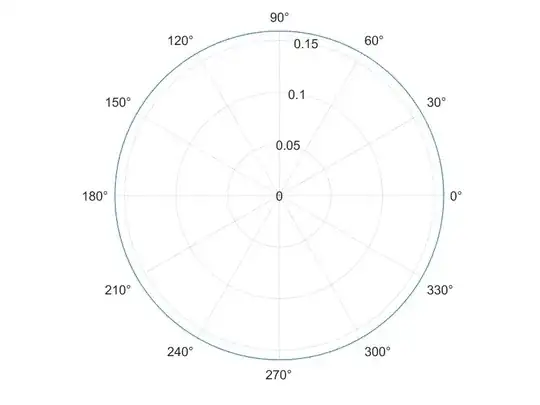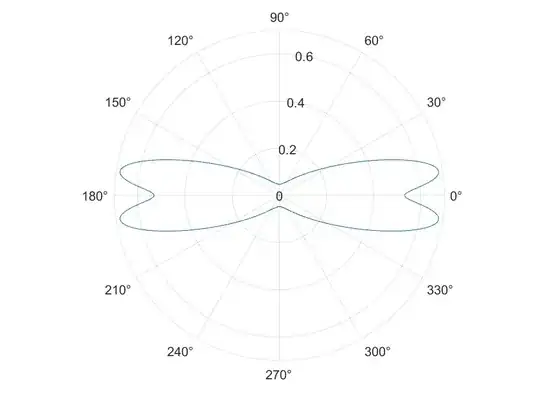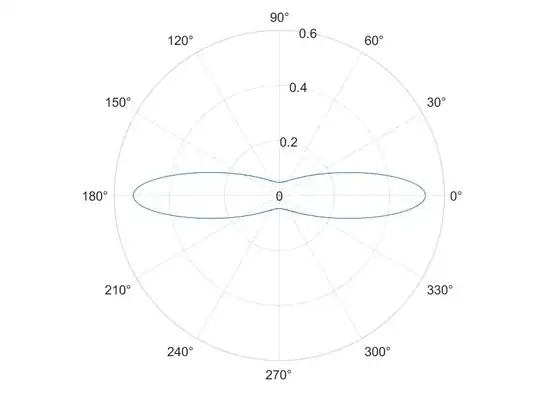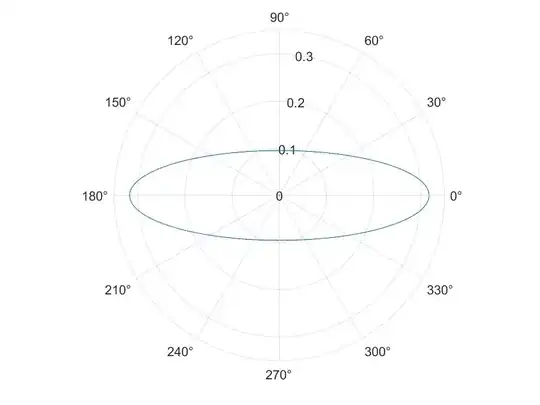I derived a uniform probability density function (PDF) on a circle, which describes the orientation distribution of fibers on a plane, by dividing the infinitesimal triangular area element of the circle containing fibers oriented in the interval $\left[\varphi, \varphi + d\varphi\right]$, which is the area of a triangle with height $r_{circle}$ (circle radius) and base $dS_{circle} = r_{circle} \cdot d\varphi$ (infinitesimal arc length of a circle), so:
$dA_{circle} = \frac{1}{2} \cdot r_{circle} \cdot dS_{circle} = \frac{1}{2} \cdot r_{circle} \cdot r_{circle} \cdot d\varphi = \frac{1}{2} \cdot r_{circle}^2 \cdot d\varphi$
by the overall area of the circle:
$A_{circle} = \pi \cdot r_{circle}^2$
and equating $dA_{circle}/A_{circle}$ to $P_{uniform,2D}\left(\varphi\right)d\varphi$. This yields the correct PDF:
$P_{uniform,2D}\left(\varphi\right) = \frac{1}{2\pi}$
which fulfills the usual normalization condition. A plot of $P_{uniform,2D}\left(\varphi\right) = \frac{1}{2\pi}$ looks circular:
Using the same (geometry-based) derivation path, I get the correct uniform PDF for the sphere:
$P_{uniform,3D}\left(\vartheta,\varphi\right) = \frac{1}{4\pi}$
A plot of $P_{uniform,3D}\left(\varphi\right) = \frac{1}{4\pi}$ looks spherical:
Now, I would like to use the same path to derive a nonuniform, two-dimensional PDF defined on an ellipse of given shape.
To do this, I first derived the ellipse radius in polar coordinates by substituting $x$ and $y$ in the "Cartesian expression" for the ellipse:
$\left(\frac{x}{a}\right)^2 + \left(\frac{y}{b}\right)^2 = 1$
by $r\cos(\varphi)$ and $r\sin(\varphi)$, respectively; and solving with respect to $r$. This yields:
$r_{ellipse} = \frac{b}{\left[\sin(\varphi)^2 + \left(b\cos(\varphi)\right)^2\right]^\frac{1}{2}}$
I use "unit ellipses" (as in unit circle, or unit sphere) with $a = 1$, which is why you don't find any occurrences of $a$ in the previous expression.
Then, I also derived the infinitesimal arc length of the ellipse by solving
$ds^2 = \left[\left(\frac{dr}{d\varphi}\right)d\varphi\right]^2 + \left(rd\varphi\right)^2$
and isolating the $d\varphi$ term from the remaiming part of the resulting expression. Specifically, I get:
$dS_{ellipse} = \frac{b^2 \left[ b^4 + \sin(\varphi)^2 - b^4\sin(\varphi)^2 \right]}{\left[b^2 + \sin(\varphi)^2 - b^2\sin(\varphi)^2 \right]^\frac{3}{2}} \cdot d\varphi$
To check the latter, infinitesimal ellipse arc length's correctness I (numerically) integrated $dS_{ellipse}$ over $d\varphi$ from $0$ to $2\pi$ and got results that were identical to those I got via the famous Ramanujan's (analytical) approximations (only for very low values of $0.01$ for the minor semi-axis $b$, did I get relative deviations of $0.34\%$ and for the worst approximation, otherwise virtually identical results, especially for $b \geq 0.3$. All these results also matched that given by the complete elliptical integral of the second kind.
The ellipse area, $A_{ellipse}$, is straightforwardly obtained from:
$A_{ellipse} = \pi b$
Now, the problem is that, if I do:
$\frac{dA_{ellipse}}{A_{ellipse}} = \frac{\left(\frac{1}{2} \cdot r_{ellipse} \cdot dS_{ellipse}\right)}{\pi b} = P_{nonuniform,2D}\left(\varphi\right)d\varphi$
or also with $dS_{ellipse} = r_{ellipse} \cdot d\varphi$ as suggested in the comments below, instead of $dS_{ellipse}$ as in the original expression further above; I either get 1) a PDF that neither exhibits an elliptical shape, nor satisfies the normalization condition (if I use the original $dS_{ellipse}$ expression), here the respective plot:
or 2) a PDF that does satisfy the normalization condition, but does not exhibit the shape of an ellipse (if I use the abovementioned $dS_{circle}$ variant), here the respective plot:
I am insisting with this need for an ellipse-shaped PDF, because I have found (in the literature) a more expedite (also geometry-based) path for deriving the nonuniform, two-dimensional PDF in question, namely by dividing the elliptical radius, $r_{ellipse}$, defined above, by the integral over $\varphi$ of the elliptical radius; so:
$P_{nonuniform,2D}\left(\varphi\right) = \frac{r_{ellipse}}{\int_{0}^{2\pi}r_{ellipse}}$
The latter PDF expression exhibits the shape of an ellipse in a polar plot:
and satisfies the normalization condition. However, I don't know how theoretically sound this latter derivation path is, which is why I was trying to reach equivalent results via the first, seemingly theoretically sounder derivation path further above.
If this latter, second derivation path is correct and the PDF should indeed exhibit the shape of an ellipse, then I think the only possible explanation for the difficulties with the former, first derivation path is that the expression for the infinitesimal triangular area element containing fibers oriented between $\varphi$ and $d\varphi$ in an ellipse, $dA_{ellipse}$, should be slightly more complicated, mainly because we have more complex infinitesimal triangular area elements (their complexity should in principle more or less match the higher complexity of the the $dS_{ellipse}$ expression vis-a-vis the $dS_{circle}$ expression). I think the infinitesimal triangular area element in question could be given by $dA_{ellipse} = (1/2) \cdot r_{ellipse} \cdot dS_{ellipse} \cdot \sin(\alpha)$, with $\alpha$ the angle between $r_{ellipse}(\varphi)$ and $dS_{ellipse}$, but I'm not completely sure. So, in case this is indeed the correct way of calculating those infinitesimal triangular area elements in the ellipse, my question is: how does one derive an expression for the angle $\alpha$, solely from knowledge of $b$, $r$ and $dS$? Is that possible at all? If it is not: what else could I be doing wrong? If nothing at all, and this geometry-based derivation path is simply not viable for ellipses (or ellipsoids), is there any other (rigorous, perhaps nongeometric) path to derive the sought, elliptical PDF fulfilling the normalization condition?
Another possibility that just occurred to me is that $P\left(\varphi\right)d\varphi$ is only valid for uniform PDFs and perhaps I need to employ some additional normalization factor when deriving nonuniform PDFs. Need to think and probably get deeper into measure and probability theory to rigorously address this issue, if I can't find answers in this forum..............




